| The Two-Part Conductus: Morphology, Dating and Authorship4 |
| 音楽エッセイのページへ戻る | 初期多声音楽 | St.マーシャル楽派へ |
| Leoninのページへ | ノートルダム楽派(conductus)のページへ |
ペロタン(Viderunt Omnes) |
| ペロタン(Alleluja Nativitas) | ペロタン Clausulaのページ | まうかめ堂さんのページへ |
| substitute clausulaのページへ | 中世音楽のページへ | その5へ進む |
| その3へ戻る |
| The Two-Part
Conductus: Morphology, Dating and Authorship4 by Jacopo Mazzeo その4(p70〜90) 1.3. Generic Interplay: Quisquis cordis et oculi, Vite perdite me legi and Occitan Contrafacta The previous sections indicated that one single poem of conductus could be subject to multiple musical settings, as well as textual reworking. However, such a particular understanding of the concept of authorship, unfamiliar to contemporary practice, did not concern only texts but music as well. In fact, cases of music borrowing were relatively common; these could cross the boundaries of the sole Latin repertoire and involve also vernacular genres, such as the Occitan and French secular monody. Songs that exploit music borrowed from elsewhere were known in the Middle Ages as contrafacta; the conductus repertoire shares music with circa 70 poems written in vernacular languages such as French, English, Anglo-Norman, German, Occitan, and Portugues-Galician. Contrafacere was at the centre of medieval creativity. In the middle ages this term did not mean the mere substitution of a new set of words for an existing tune, but had more active connotations. 前のセクションでは、 conductusの1つの詩が複数の音楽設定とテキストのリワークの対象になる可能性があることを示した。 しかし、著者の概念へのこのような特殊な理解は、テキストだけでなく音楽にも関係していた。 事実、音楽を借用するようなケースは比較的一般的であった。 これらはラテン語レパートリーの境界を越え、オック語やフランス語などの俗語のジャンルも含んでいる。 他の場所から借用された音楽を発展させた歌は、中世ではcontrafactaとして知られていた。 contrafactaのレパートリーは、フランス語、英語、アングロノルマン語、ドイツ語、オック語、ポルトガル語、ギリシャ語などの言語で書かれたおよそ70の詩と音楽を共有する。 Contrafacereは中世の創造性の中心であった。 中世では、この用語は、既存の曲のための新しいセットの単なる置き換えを意味するのではなく、より積極的な意味を持っていた。 The artist of the contrafactum was more than an idle recycler: he was rather a new author. The school of Notre Dame itself developed most of its repertoire following a creative process that involved the re-working of pre-existent material, and in doing so, set a trend that strongly influenced the future development of Western music culture. The process of re-creating, re-inventing, re-using musical material is the mirror of a culture that relied predominantly on oral transmission. As far as these processes are concerned, the contrafactum embodies a remarkable mirror of cultural interactions between the sacred and the secular environments. One particular example of this are the conducti Quisquis cordis et oculi and Vite perdite me legi and their Occitan contrafacta. This case study will be used to illustrate the interaction between the conductus and the Occitan repertoire. contrafactumのアーティストは偶像再生産者以上のものであった。彼はむしろ新しい著者であった。 ノートルダム楽派自体は、既存の素材をリワークするという創造的なプロセスの後で、そのレパートリーの大部分を開発した。そうすることで、今後の西洋音楽文化の発展に強く影響する傾向を作った。 音楽素材の再創造、再発明、再利用のプロセスは、主に口頭伝播に依存していた文化の反映である。 これらのプロセスに関する限り、contrafactumは神聖な環境と世俗的な環境との間の文化的相互作用の顕著な反映を体現している。 これの具体的な例としては、conducti Quisquis cordis et oculiとVite perdite me legiとオック語の contrafactaがある。 このケーススタディは、conductusとオック語のレパートリーとの相互作用を説明するために使用される。 The present understanding of music authorship, which coincides with that of “intellectual property”, might suggest centring on the question “who wrote the music first?”; yet, we should also ask ourselves “how” the various versions differ from each other, and to what degree. The focus on the “how” may not provide author attributions; but it will help define the nature of such cultural crossover. Imitation grounds the structure of medieval creative process to such a degree that “plagiarism” was often seen more as a cunning expedient than simple theft.137 「知的財産」と一致する現在の音楽著作権の理解は、「誰が音楽を最初に書いたか?」についてが中心となっているが、我々はまた、様々なバージョンがお互いにどのように「どのように」異なっているかを自問する必要がある。 「方法」に焦点を当てると、著者の属性が得られないことがある。 だがそれは、そのような文化的相互関係の性質を定義するのに役立つだろう。 模倣は、”盗作”が単なる盗難よりも狡猾な手段として見なされるほどの、中世の創造的過程の構造なのである。 137 The troubadour Arnaut Daniel was involved in a famous episode. The razo for his song Ancieu non l'aic mas elha m'a tells that Richard I the Lionheart engaged him and another poet in a challenge. The two musicians were given ten days to compose a song, the best song was to win. According to the razo, Arnaut spied on his opponent in order to copy his song; at the end of the tenth day he offered to sing first. Obviously his opponent could not repeat the same song, and consequently lost the challenge. For the full text of the razo see Guido Favati, ed., Le biografie trovadoriche; testi provenzali dei secc. XIII e XIV (Bologna: Libreria antiquaria Palmaverde, 1961), 211. On “plagiarism” in the Middle Ages cfr. Morris Bishop, The Middle Ages (New York: American Heritage Press, 1970), 256. Edward Grant, The Foundations of Modern Science in the Middle Ages: Their Religious, Institutional, and Intellectual Contexts (Cambridge; New York: Cambridge University Press, 1996), 13. 137 troubadour Arnaut Danielは有名なエピソードに関わっていた。 彼の歌「Ancieu non l'aic mas elha m'a」のためのrazo( The razo is an “explanation” of the circumstances that have generated the song that introduces, acting as a sort of preface)は、リチャード獅子心王が、 troubadour Arnaut Danieと他の詩人とを挑戦させたことを伝えている。 2人は作曲のために10日間を与えられた。勝つためには、最高の歌を作ることであった。razoによれば、Arnautは彼の歌を筆写するために、敵をスパイした。 10日の終わりに、彼は最初に歌うことを申し出た。 彼の相手は同じ曲を繰り返すことができず、結果的にチャレンジを失った。 The first tune considered here was used for the conductus Quisquis cordis et oculi, whose poem is by Philip the Chancellor. It is also set to the well-known Occitan song Can vei la lauzeta mover, by the troubadour Bernard de Ventadorn. The second melody sets to music Peter of Blois’ Vite perdite me legi and Peirol’s Per dan que d’amor m’aveigna.138 Other poems sharing the same music are listed in the tables that follow (Table 1.10 and 1.11). According to the extant sources, the two tunes mentioned above are the only cases of interaction between the Latin repertoire of conducti and the Occitan corpus of the troubadours.139 まず最初の曲は、Philip the Chancellorの作詩であるconductus Quisquis cordis et oculiのために使用されたものである。 それはまた、よく知られているオック語の歌、トロヴァドールBernard de VentadornによるCan vei la lauzeta moverとも関係している。 2番目のメロディーは、Peter of Blois’のVite perdite me legiとPeirolの Per dan que d’amor m’aveignaにつけられたものである。同じ音楽を共有する他の詩は、次の表にリストされている(表1.10と1.11)。 現存する資料によれば、上記の2つの曲は、ラテン語のconductiレパートリーとオック語のトロバドールの作品との間の相互作用の唯一のケースである。 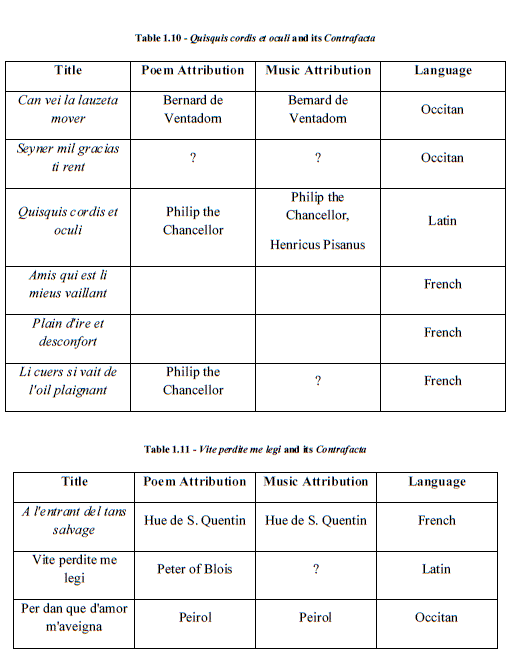 On the contrary, cases of interaction between the Latin and the French repertoires were much more common, as the tables above clearly suggest. At least fifty such cases can be counted within the whole conductus repertoire. The divergence is therefore mirrored in scholarly studies; Hans Tischler’s thorough examination of the relationship between conducti and vernacular songs represents clear sign of such a discrepancy.140 This recent work mostly sheds light on northern-French and partly German repertoires, and the lack of focus on other vernacular traditions is self-evident. Explanations for such a solid interaction between conducti composers and trouveres can probably be put down to geographical movement, which also explains the paucity of Occitan contrafacta. 逆に、ラテン語とフランス語の相互作用のケースは、上記の表が明らかに示唆しているように、より一般的であった。 そのような場合は、conductus全体のレパートリーの中で少なくとも50個は数えられる。 したがって、その状況は学術研究に反映されている。 conducti と vernacular songsとの関係の Hans Tischlerの徹底的な調査は、これらの齟齬の明確な兆候を示している。この最近の研究は、主に北部フランス語と一部のドイツ語レパートリーに光を当て、他の世俗的伝統に焦点を当てていないことは自明である。 conducti作曲者とトロヴェールの間のこのような強固な相互関係は、おそらくオック語 contrafactaの研究の不足にもとづく地理的な偏りが原因なのであろう。 Can vei la lauzeta mover appears in several studies, where it is generally considered as the original manifestation of this tune, among the long list of songs that share the same music.141 Despite issues of authorship, of more interest here is the relationship between the repertoires, their interaction, and the way counterfeiting affected different musical cultures. Can vei la lauzeta moverはいくつかの研究に資している。この音楽は、同じ音楽を共有する長い歌のリストの中で、この音調のオリジナルであると一般に考えられている。著者の問題にもかかわらず、 レパートリー、その相互作用、および偽造の影響を受けたさまざまな音楽文化に影響を与えている。 Can vei la lauzeta mover is attributed to the troubadour Bernard de Ventadorn (c.1130-c.1190) in several sources, among them F-Pn fr. 22543 and F-Pn fr. 844. Four further songs complete the list of contrafacta: the French Amis qui est li mieus vaillant, Plain d’ire et desconfort, Li cuers si vait de l’oil plaignant, and the Occitan Seyner mil gracias ti rent.142 The poem of the Latin contrafactum Quisquis cordis et oculi has been attributed to several authors. While its ascription to Walter Map in the manuscript GBCccc 481 is unlikely,143 it can be safely attributed, as previously mentioned, to Philip the Chancellor (according with Salimbene de Adam, who also credits the music to Henricus Pisanus).144 Can vei la lauzeta moverは、F-Pn fr. 22543 写本と F-Pn fr. 844写本中のいくつかの資料で、トロバドールBernard de Ventadorn(c.1130-c.1190)の著作であると考えられる。 さらに4つの歌が、フランス語のAmis qui est li mieus vaillant、Plain d'ire et desconfort、オック語のSeyner mil gracias ti rent、などのcontrafactaのリストを完成させる。 ラテン語のcontrafacta Quisquis cordis et oculiは、いくつかの著者が考えられている。 GBCccc 481写本のWalter Mapへの帰属は考えにくいが、前に述べたように、Philip the Chancellor(Henryus Pisanusが音楽を担当したとする、Salimbene de Adamによれば)作と考えることが無難であろう。 The attribution of Quisquis cordis et oculi’s music as delivered in F is complicated.145 The passage in which Salimbene credits the music to Henricus is ambiguous (p. 55). Yet it is not unrealistic that Henricus’ music could have travelled to Paris in time to be recorded in F. On the other hand it is also possible that Henricus simply wrote different music that does not survive in any extant source. At the time when Salimbene met Henricus, around 1240s, the poem was widely disseminated across Europe, and was probably subjected to several music settings. The text is in fact preserved without music by 27 sources, compiled across Europe (Switzerland, Czech Republic, Germany, Spain, France, Great Britain, Italy, and Poland).146 The music, on the other hand, is only recorded in manuscripts compiled in French regions,147 with the exception of I-Rss XIV L3, which is of Italian origin yet also records the same music found in the French sources.148 Although it is possible that Salimbene used I-Rss XIV L3 (or a related source) as a reference, this would have happened at a later stage in the compilation of the chronicle.149 F写本で伝達されているQuisquis cordis et oculiの音楽の帰属は複雑である。 Salimbeneが、その音楽をHenricus作とする一節はあいまいである(55ページ)。しかし、Henricusの音楽がF写本に収録されるのは時間の経過とともにパリに向かったとするのは現実的でなくもない。一方、Henricusは、現存する資料に残っていない別の音楽を書いた可能性もある。 SalimbeneがHenricusに会った頃、約1240年代、この詩はヨーロッパ全域に広く流布され、おそらくいくつかの音楽がつけられていた。このテキストは実際には、ヨーロッパ全土(スイス、チェコ共和国、ドイツ、スペイン、フランス、イギリス、イタリア、ポーランド)で編集された27のソースによって音楽なしで保存されている。一方、音楽は、イタリア語起源でフランス語資料に同じ音楽が記録されている I-Rss XIV L3写本を除いて、フランスの地方で編纂されたものである。SalimbeneがI-Rss XIVL3写本やその類似のものを参照した可能性はあるが、これはおそらく、年代誌の編纂のより後の段階で起こったことなのだろう。 Quisquis cordis et oculi is a strophic conductus; its seven stanzas are recorded in almost all sources. Among musical sources the only exception is F, which presents the first stanza only and no room is left on the page for the remaining six stanzas (Figure1.2). Within F this is not an exception; in several other cases only the first stanza of strophic conducti is recorded.150 This suggests that a complementary manuscript of poems was available at Notre Dame, featuring the full lyrics. Furthermore, the existenceof a collection of texts without music would explain the wide circulation of some lyrics as poems rather than as songs.146 Quisquis cordis et oculiは有節のconductusである。 その7つのスタンザはほぼすべての資料に記録されている。 資料の中で唯一の例外はF写本で、これは最初のスタンザのみを示し、残りの6つのスタンザのためのページの余裕がない(Figure1.2)。 F写本では、こうしたことは例外ではない。 いくつかの他の事例では、最初のスタンザのみが記録されている。これは、詩の補足的な写本がノートルダムで利用可能であったことを示している。 さらに、音楽を伴わないテキストの収集の存在は、歌ではなく詩としてのいくつかの抒情詩の広い流布を説明する。 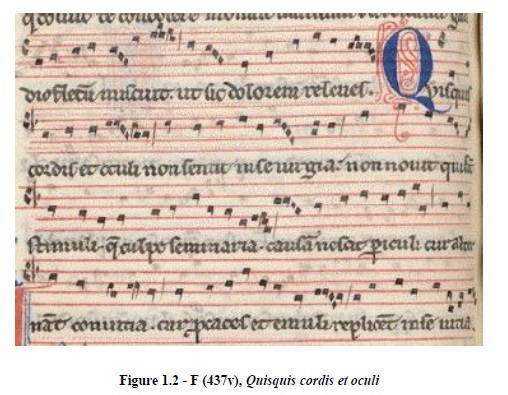 This poem can only be dated between the 1180s and 1236, as it is credited to Philip the Chancellor (c.1160-1236), while the text of its contrafactum Can vei la lauzeta mover was probably written earlier, around the mid-twelfth century.151 Consequently, the period during which the melody could have been written overlaps by about two decades (c.1180s-1190s), leaving no chance to state which of the two poems was first to be set to the music they share in the extant sources. The wide dissemination of Quisquis cordis et oculi as a poem, and of Can vei la lauzeta mover as a song, should not simply lead to the conclusion that Bernard preceded Philip . or Henricus . writing the tune. Furthermore, it is not impossible that the music could have existed beforehand. この詩は1180年代と1236年の間に書かれているが、作者はPhilip the Chancellor (c.1160-1236)とされている。contrafactum Can vei la lauzeta moverは、おそらく12世紀半ばか早期に書かれたものであった。引き続き、メロディーが書き込まれた期間は約20年(c.1180年代‐1190年代)と重なり、2つの詩のうちどれが現存する音楽に最初に設定されたのかは判然としない。Quisquis cordis et oculiの詩としての幅広い普及と、leaving no chance to stateの歌としての広範な普及は、BernardがPhilipまたはHenricusに先行したという結論に単純に導くべきではない 。 さらに、音楽があらかじめ存在していた可能性も否定できない。 The sources for Quisquis cordis et oculi’s several contrafacta reveal processes of melody adaptation. The analysis of the discrepancies between the variants of Can vei la lauzeta mover shows that the lectio of F-Pn fr. 844 is more linked to Quisquis cordis et oculi than to other testimonies of the Occitan song itself featured in F-Pn fr. 22543 and in I-Ma R 71 sup. In general, musical incongruities between variants of both songs are generally more quantitative (e.g. embellishments in place of a single note) than qualitative (different pitches), and sometimes highlight choices due to language needs, as the comparison of the first lines of Can vei la lauzeta mover and Quisquis cordis et oculi demonstrates (Music Example 1.1): Quisquis cordis et oculiのいくつかのcontrafactaの資料は、メロディの採用のプロセスを明らかにする。 Can vei la lauzeta moverのvariants間の相違を分析すると、F-Pn fr. 844写本中のlectioが、F-Pn fr. 22543写本や I-Ma R 71写本中のオック語の歌よりも、Quisquis cordis et oculiとリンクしていることが示される。 一般に、両方の曲のvariants間の音楽の不協和は、定性的(異なる音程)であるよりも一般的には定量的であり(例えば単一の音符の代わりの装飾がくる)、Can vei la lauzeta mover (オック語)と Quisquis cordis et oculi(ラテン語)の最初の1行の比較として、時には言葉の選択の必要性が強調される。(Music Example 1.1): 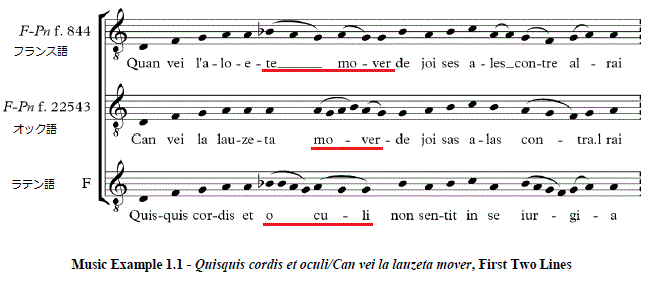 メロディの違いというよりも装飾の違い。赤線はメリスマ While F-Pn fr. 22543 shows a melisma on the last two syllables of the line (mover), F 写本や F-Pn fr. 844 写本start embellishing from the antepenultimate syllables: respectively .te mover and oculi. The choices of both F-Pn fr. 22543 and F are justified, since the melisma starts on the last stressed syllable of the line (respectively mo- and o-). On the contrary F-Pn fr. 22543 highlights the weak syllable .te, a choice that would not find explanation unless we hypothesise a link between F-Pn fr. 844 and F’s lectio. The closer relationship between F and F-Pn fr. 844 is repeated on the fourth line of the songs. F-Pn fr. 22543写本では、行の最後の2つの音節(mover)上のメリスマを示す一方、、F 写本や F-Pn fr. 844 写本は、最後の2つの音節より前からの装飾を開始する。それぞれ、 te moverと oculi.である。F-Pn fr. 22543写本とF写本の両方の選択は正当である。なぜなら、 メリスマは行のアクセント音節(それぞれmo-とo-)で始まるからである。 反対に、F-Pn fr. 844は、(メリスマによって)弱いシラブル‐teを強調する。この選択は、F-Pn fr. 844とFの lectio間のつながりを仮定しない限り、説明ができない。 F写本とF-Pn fr. 844とのより密接な関係は、歌の第4行でも繰り返される。 There, both the two codices present syllabic music over the entire line, while FPn fr. 22543 delivers an embellished passage on the fourth syllable .sor. Similarly, F and F-Pn fr. 844 start the following line (Music Example 1.2) with a four-note melisma on the syllables he! and cau-, and proceed with syllabic music. In F-Pn fr. 22543 this passage seems inverted, as the line ends with a melisma on the penultimate syllable m’en-. One last example is found in the seventh line (Music Example 1.3), on the penultimate and anti-penultimate syllables: F-Pn fr. 22543 proceeds with an interval of an upper second, while F and F-Pn fr. 844 both begin a third down. F‐Pn fr. 22543写本が第4シラブル‐.sorに装飾された一節を提供する一方、別の2つの写本は両方とも、第4行全体にわたってシラビックな音楽を提示している。同様に、F写本およびF-Pn fr.844写本は、シラブルhe! とcau-の部分で4つのメリスマでもって、第5行が始まっている。そしてその後に、シラビックな音楽が続く。 F-Pn fr.22543では、この一節は、行が最後から2番目のシラブルのメリスマm’en-で終わるので、反転して見える。 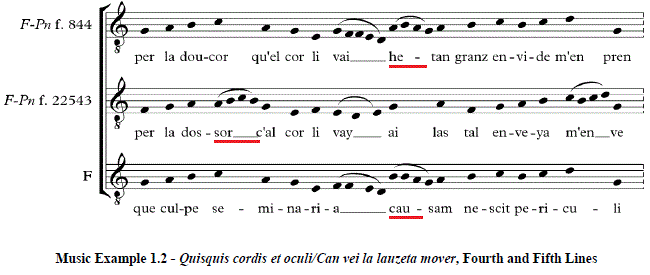 最後の例は、第7行(Music Example 1.3)、最後から2番目とその前のシラブルである。F写本とF-Pn fr. 844写本の両者が3度下がる間、F-Pn fr. 22543は2度上昇する。 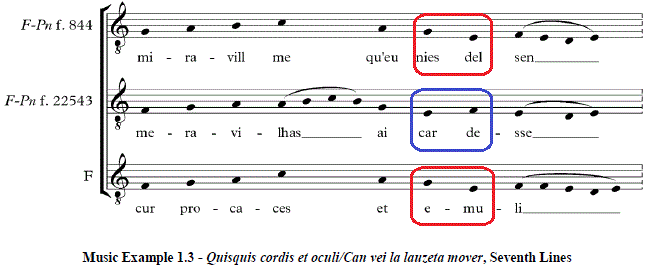 The second case-study involves the Occitan poem Per dan que d’amor m’avegna, written by the troubadour Peirol, and the Latin Vite perdite me legi by Peter of Blois.152 Peirol’s birth date is considered to be around 1160,153 and it is assumed that he composed most of his works between 1185154 and 1221 or 1222, after which date he appears to have been in Italy.155 The Latin author, Peter of Blois, appears to have been a few decades older, since he lived between 1135 and 1211.156 As for the previous case, the two authors still share a period of activity towards the turn of the thirteenth century (c.1175-1210), which makes it impossible to infer which of the two poems was first set to the extant melody. 2番目のケーススタディは、トロバドールPeirol作のオック語の詩Per dan que d’amor m’avegnaである。ペイロールの生年月日は約1160年、 彼は1185年から1221年または1222年の間に彼の作品の大部分を作ったとされ、その日以後にはイタリアにいたようだとされている。ラテン語作者Peter of Bloisは、若干年長で、1135−1211年まで生きた。前のケースでは、2人の著者は13世紀のターンに向けてまだ活動期間を共有しているため(c.1175-1210)、2つの詩のどちらが現存するものに最初に設定されたのかを推測することは不可能である。 The date of the manuscript is of no help in dating the composition. Most of the featured songs of both I-Ma R 71 sup and F are considered to have been composed much earlier than the actual compilation of the codices, specifically in the twelfth century.157 D-Mbs clm. 4660 (also known as the “Codex Buranus”) is the oldest manuscript among the group taken into consideration for this study and also contains a repertory originating during the late twelfth century,158 but it is different from the previous sources as it delivers adiastematic neumes rather than squared staved neumes. 写本の日付は、作曲の日付を同定するのに役には立たない。 I-Ma R 71 sup写本とF写本の両方の特徴的な歌のほとんどは、12世紀の写本の実際の編集よりもはるかに早く作られたものだと考えられている。D-Mbs clm.4660(”Codex Buranus”とも呼ばれる)は、この研究で取り上げられたグループの中で最も古い写本であり、12世紀後半に始まったレパートリーも含まれている。しかし、それ以前の資料からは異なっていて、squared staved neumes.よりもadiastematic neumesを扱うようになっている。 It is clear, then, that biographical information and data inferred from the sources are of little or no benefit to the dating of the melody. Yet, they help the description of how the repertoires influenced each other, and the process of circulation of this music. Between 1209 and 1229 the cruel Albigensian crusade replaced a period of relative quiet in France, and it may be considered the main event that saw northern and southern French cultures interacting and influencing each other. In particular, the city of Toulouse can be reckoned as the crossroad of this network. In a 1997 article, Elizabeth Aubrey pointed out that the southern . Occitan . culture affected northern France more than vice versa, finding evidence from the production and geographical dissemination of troubadour and trouvere sources.159 The fact that most of the main Occitan sources have been copied in non-Occitan regions, while manuscripts with French lyrics have been mainly produced within the area in which they actually originated, proves her claim. 資料から推測された伝記的な情報やデータは、メロディーの日付を特定することにほとんどまたはまったく有益ではないことは明らかである。しかし、レパートリーがどのようにお互いに影響を与えたか、そしてこの音楽の流布過程についての説明を手助けしている。 1209年から1229年の間、残酷なアルビジョワ人の十字軍は、フランスに相対的な静穏をもたらした。そして、北部と南部のフランス文化が互いに影響を及ぼし合うようになった。特に、Toulouseはこのネットワークの交差点と見なすことができる。 1997年の記事で、Elizabeth Aubreyはトロバドールやトロヴァールの産生や地理的拡散からの証拠を見出して、南部のオック語の文化が、北フランスに影響を及ぼした、と指摘した(その逆ではない)。フランス語の抒情詩の写本は彼ら自身が活動した地域で産生されたのに対して、メインのオック語資料の大部分はオック語地域ではないところで筆写されたという事実は、彼女の主張を証明している。 Aubrey’s statement may be accurate in that she focussed on the vernacular repertoire only, but as far as the relation of the Occitan culture with Latin productions is concerned, we must be more cautious in positing which tradition might have affected the other. Per dan que d’amor is one of the 18 songs by Peirol that survives with music. The only source containing musical information for this vernacular testimony is I-Ma R71 sup (46r-46v). As previously mentioned, two contrafacta of this song exist with French or Latin verses. Besides Peter of Blois’ conductus Vite perdite me legi, we find a French variant: A l’entrant del tans salvage by the trouvere Hue de Saint-Quentin.160 While the abundant number of text-only sources of Quisquis cordis et oculi led us to the hypothesis that it might have originally circulated as a poem, the consistent and large number of music sources for this second case suggests that both Vite perdite me legi and Per dan que d’amor might instead have always been intended as songs. Aubreyの声明は、母国語のレパートリーのみに焦点を当てている点で正確かもしれないが、オック語の文化とラテン語作品産生との関係については、どの伝統が他に影響を与えているのかをより慎重に見極める必要がある。 Per dan que d'amorはPeirol作の現存する18曲のうちの1曲である。この母国語証言の音楽情報を含む唯一の資料はI-Ma R71 sup写本(46r-46v)である。前述のように、この歌の2つのcontrafactaは、フランス語またはラテン語のversesに存在する。 Peter of Blois’のconductus Vite perdite me legiの他に、フランス語のvariant A l’entrant del tans salvage (by the trouvere Hue de Saint-Quentin)も見つかっている。Quisquis cordis et oculiのテキストのみの豊富な資料は、それが詩として流布したように思わせるが、この第二のケースであるPer dan que d’amor m’avegnaの一貫した多くの音楽資料は、Vite perdite me legi とPer dan que d’amorともに、歌として意図されたことが示唆される。 Since each source presents a different mise en page, a look at how the songs have been graphically designed in these manuscripts might help the comparative description of the variants. In I-Ma R 71 sup the first two stanzas of Per dan que d’amor are set to music, then the rest are text only (Figure 1.3 and Figure 1.4). Considering that this song is musically strophic, this particular setting looks quite unconventional: within this repertoire . and specifically this manuscript .161-we would expect music to appear only once, only for the first stanza. The copyist’s purpose was possibly to highlight the coblas dobla, the poetic peculiarity of the song,162 instead of any music characteristics. 各資料は異なるレイアウトmise en pageを提示するので、これらの写本でどのように歌が写実的に描写されているかを見ると、variantsの比較に役立ちつ。 I-Ma R 71 sup写本では、Per dan que d'amorの最初の2つのスタンザが音楽に設定され、残りはテキストのみである((Figure 1.3 and Figure 1.4)。 この曲が音楽的に有節的なものであることを考えると、この特殊な設定は、このレパートリー中で、特にこの写本中で、慣習とは異なっている。最初のスタンザのみで、音楽が一度だけ出現することが期待される。書記の目的は、音楽の特性の代わりに、歌の詩的な特異性であるcoblas dobla(トルバドゥールの芸術様式で、オック語抒情詩のスタンザのこと)を強調することであった。 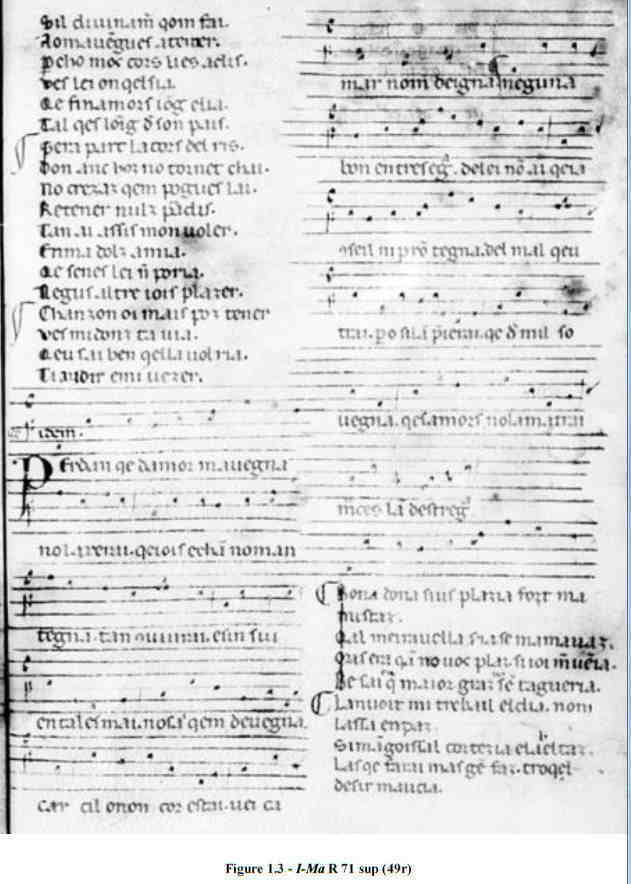  Compared to Per dan que d’amor, the French contrafactum shows a more conventional setting; the first stanza alone is set to music, while the rest of the poem is without melody. Vite perdite me legi interestingly delivers two different musical variants of the same song: the counterfeited music material is shared between the tenor of a polyphonic version and a monody. F, compared to the other sources, records the first stanza only. It seems to imply, as in the previous case of Quisquis cordis et oculi, that the whole poem was easily accessible somewhere else. Per dan que d'amorと比較して、フランス語のcontrafactumはより慣習的な設定を示している。 最初のスタンザだけが音楽に設定され、残りの詩はメロディーがない。 Vite perdite me legiは興味深いことに、同じ歌の2つの異なる音楽のvariantsを提供する。模倣された音楽素材は、多声音楽版のテノールと単声とで共有される。F写本は、他の資料と比較して、最初のスタンザのみを記録している。 Quisquis cordis et oculiの前のケースのように、全体の詩が他のどこかに簡単にアクセスできることを暗示しているようである。 On the contrary, the monody found in D-Mbs clm. 4660 not only displays the whole poem, but it has been completely notated with staffless neumes. Yet, this should not surprise us, and does not devalue the hypothesis that the song might have circulated first as a poem. In fact, such idiosyncrasies are typical of the whole manuscript. More than one piece with testimonies in both F and D-Mbs clm. 4660 presents analogous relationships. For instance the conducti: Ave nobilis, O varium fortune and, to some degree, Procurans odium.163 他方、、D-Mbs clm. 4660 写本中の単声曲は、全体の詩を表示するだけでなく、旗のないネウマ譜で記譜されている。しかし、これは私たちを驚かせるものではなく、歌が最初に詩として流布されたかもしれないという仮説をみくびっていない。 実際、そのような特質は写本全体の典型である。 F写本とD-Mbs clm. 4660の両方に現れる1つの作品以上は、類似の関係を提示する。 例えば、conducti::Ave nobilis、O varium fortuneとProcurans odiumとのように。 When it comes to the prosody, Peirol’s poem (for which the first stanza is given in Table 1.12) has an ababbaba rhyme scheme, and on the whole it represents a clear example of coblas doblas, as anticipated. Specifically, in the first two stanzas the rhymed syllables are -igna and -ai, whilst in the third and fourth stanzas -ia and -atz. Finally in the last three stanzas -atge and -es alternate each other. 韻律では、Peirolの詩(Table 1.12に最初の節がある)には、ababbabaの韻スキームがあり、全体として、それは予期されるように、coblas doblasの明確な例を表している。 具体的には、最初の2つのスタンザでは、韻を踏んだ音節は-ignaと-ai、3番目と4番目の-anzと-atzでは-aiである。 最後の3つのスタンザでは、-atgeと-esがお互いに交互になる。 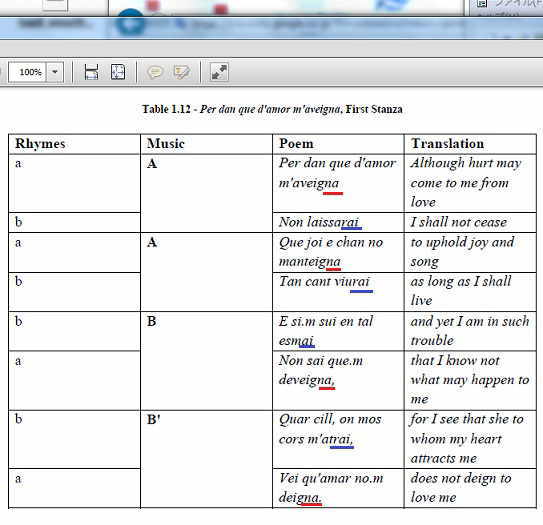 The conductus’ rhyme scheme is far less self-evident than its vernacular parallel, and it is subjected to divergent scholarly interpretations. On the one hand Anderson suggests a ten-line stanza reading; on the other hand Hendrik Van der Werf, whose main concern is the Occitan variant, gives Vite Perdite an eight-line stanza interpretation that is clearly influenced by his analysis of Per dan que d’amor.246 As a consequence, we face two different, although both possible, stanza readings of the same song: one in ten lines, another one in eight lines (cfr. Table 1.13). conductusの韻スキームは、その母国語の並行スキームよりはるかに自明ではなく、多様な学術的解釈を受けている。 一方で、Andersonは10行のスタンザを示唆しているが、他方.Hendrik Van der Werfは、オック語のvariantに関心を持ち、Per dan que d’amor.の分析によって明らかに影響を受けてVite Perditeに8行のスタンザの解釈を与えている。 結果として、私たちは、同じ曲の2つの異なったスタンザの読みに直面している。.1つは10行に1つ、8行にはもう1つである。(cfr. Table 1.13).)。  Such a discrepancy is due to poetical and musical features. The main poetic difference lies in the rhyme scheme. Vite perdite me legi displays an internal rhyme in the first line (vite perdite | me legi) and in the third line (minus licite | dum fregi) that does not correspondingly appear in Per dan que d’amor. このような矛盾は、詩や音楽の特徴によるのである。 主な詩的な違いは、韻の仕組みにある。 Vite perdite me legiは、第1行(vite perdite | me legi)と第3行(minus licite | dum fregi)の内部韻を示している(Per dan que d'amorには相当するものがない)。 Vite perdite | me legi can be either read as a single line, rhyming minus licite | dum fregi, or split into two different lines, as they will still match (in both rhyme and number of syllables) their own following verses. On the contrary Per dan que d’amor does not show any internal rhyme that could allow us to split the lines accordingly. Furthermore, such splitting would corrupt the whole coblas doblas structure. As a consequence, a reading that takes into account both the Occitan and the Latin poems would likely opt for eight-line stanzas, as van der Werf does,247 whilst the obvious reading that follows the sole analysis of the Latin contrafactum would suggest ten lines instead. Further evidence of such a discrepancy comes from some notationalcharacteristics. The examination of Vite perdite me legi’s variant in F reveals agraphical division between the words perdite and me legi (Figure 1.5). Vite perdite | me legi は、単一行、押韻しているminus licite | dum fregiとして読譜できるし、あるいは、それらがさらに自身に従うversesに合うように(韻とシラブルの両者において)、2つの異なった行に分割することもできる。対照的にPer dan que d'amorは、それに応じて行を分割することができる内部の韻を表示していない。 さらに、そのような分割は、coblas doblas構造全体を破壊することになる。 結果として、オック語とラテン語の詩の両方を考慮した読譜では、van der Werfのように8行のスタンザを選ぶ可能性が高いのに対し、ラテン語のcontrafactumの唯一の分析は10行を支持する。 このような不一致の証拠は、いくつかの記譜法の特性から生じる。 F写本中のVite perdite me legiのvariantsの調査は、perdite と me legiの語の間の見た目の分割を明らかにする(Figure 1.5)。 The vertical stroke separates the two sections in both the upper part and the tenor. Whatever we consider this stroke . a breath, a rest or just a silbenstrich .248 it highlights the importance of the rhyme between perdite and licite, giving them a graphical recognition. According to this silbenstrich, we can reasonably separate the two lines at this point.249 The second part of the stanza is not symmetrical to the first. The lines sed a vite | vesperam and quicquid ante | perperam should not be split, despite containing an internal consonance between vite and ante; furthermore, the manuscript does not show any graphical division following these words. 垂直ストローク線は、上声部とテノールの両方の2つのセクションを区切っている。 私たちがこのストロークをブレス、休息、あるいはsilbenstrich(The concept of Silbenstrich( a vertical stroke drawn through part of the staff to indicate a change of syllable)と考えるもの、それは、彼らにグラフィカルな認識で、perdite とliciteの間の韻の重要性を強調します。 このSilbenstrichによれば、この時点で2つの行を合理的に分離することができる。スタンザの第2部分は第1部分とシンメトリカルではない。 行は、sed a vite | vesperamと quicquid ante | perperamとの間では分割されるべきではない。vite と ante の(進行する)間には内部協和音程を含むにもかかわらず、写本にはこれらの言葉をフォローする図式的な分割は見られない。  Figure 1.5 - F (356r), Vite perdite me legi In musical terms, the tune is made of a regular sequence of ten five-to-seven neume-phrases, which would fit the ten-line stanza interpretation of the poem. Yet, Aubrey suggests that the tune has an ABA’B’ CDC’D’ structure, where again each letter corresponds to a line of the poems, according to the eight-line stanza reading, which best matches the Occitan text.250 These two musical interpretations clearly mirror different understandings arising from the study of the same tune in either its Latin version or its Occitan contrafactum. In view of these elements we can hypothesise that the tune fits the Latin poem better than its Occitan variant. In fact, its melodic structure (ten equally-long segments) seems purposely composed to fit a ten-line stanza poem (Vite perdite me legi), rather than a shorter one (Per dan que d’amor). 音楽的に言えば、音調は、10行スタンザの詩の解釈に適合するような10個の5-7のネウマ句の規則的な連続で作られている。 しかし、Aubreyは、この曲はABA'B 'CDC'D'構造を持っていることを示唆している。ここで、それぞれの文字は、8行のスタンザの読譜によると、オック語のテキストに最もよく適合する。 これらの2種類の音楽的解釈は、ラテン語版またはオック語のcontrafactumのいずれに対しても同じ音調がつくことを研究することから来る異なった理解をはっきりと映し出している。 これらの要素を考慮して、我々は、こうした音調は、オック語のvariantsよりもラテン語詩によく合うという仮説を立てることができる。 実際、そのメロディー構造(10の等しいロングの分画)は、短いスタンザ(Per dan que d’amor).ではなく、10行のスタンザの詩(Vite perdite me legi)に合うように意図的に作曲されているようだ。 However, according to Aubrey, a melodic discrepancy between the sources would instead suggest Peirol’s original authorship.251 The starting note of Per dan que d’amor is c, while in all of the other contrafacta the melody starts on g. Since the music is strophic, and in all versions the stanza ends on g, the interval between these two notes will be a lower fifth in Per dan que d’amor, not uncommon in troubadour music,252 and would instead make a unison in all the other versions. As this g-c gap is featured in the troubadour version only, but in none of the other contrafacta (neither in A l’entrant del tans salvage, nor in Vite perdite me legi), Aubrey is perhaps applying here, to some degree, the lectio difficilior. It is true that Peirol’s melodies often show even wider jumps between the end of a stanza and the following reprise of its music,253 yet the unison is by far the most common interval. If we are willing to agree that the composer of F’s Vite perdite me legi is borrowing the melody from Peirol to build a polyphonic setting, we should accept that he has deliberately changed the pitch of the very first note with the purpose to simplify this passage, while at the same time several other jumps of a fifth throughout the tune are not subjected to any sort of modification. This option is highly unlikely; it is instead more probable that the version of the music set to Vite perdite me legi is older than that of Per dan que d’amor. However, the absence of any clear evidence to support either of the two possibilities impedes the delineation of any chronological antecedence. しかし、Aubreyによれば、資料間のメロディの不一致は、もともとの原作者Peirolを示唆するのであろう。Per dan que d'amorの始まりはド音であり、他のすべてのcontrafactaのメロディーはソ音で始まっている。音楽は有節的であり、すべての版でスタンザはソ音で終わるので、これらの2つの音符の間隔は、Per dan que d'amorにおいては、低い5度となるが、これはトロバドールの音楽においては、珍しいことではなく、他のすべての版では、代わりにユニゾンとなっている。このソ音‐ド音のギャップは、トロバドール版のみの特徴であるが、他のcontrafacta(neither in A l’entrant del tans salvage, nor in Vite perdite me legi)では見られない。Aubreyはおそらくある程度は、lectio difficilior(「より難しい読みの方を採用する」という原則)に適応させているのであろう。Peirolのメロディーでは、スタンザの終わりとそれに続く音楽の再現との間にさらに広いジャンプが見られることはよくあるが、それでも一番の共通点はユニゾンである。 F写本中の Vite perdite me legiの作曲家がPeirolのメロディーを借りて多声的な設定を作り上げていることに同意したい場合は、この一節を単純化する目的で、最初の音符の音高を意図的に変更せねばならない。同時に、曲すべての5度の跳躍が、いかなる改変も受けないようにしなければいけない。このオプションはほとんどあり得ない。その代わりに、Vite perdite me legiに設定された音楽のバージョンがPer dan que d'amorのそれより古い可能性がある。しかし、2つの可能性のいずれかを支持する明確な証拠がないと、年代順の記述が妨げられる。 1.4. Conclusion Since poets and composers from most areas of the Christian Europe contributed to the birth, expansion, and development of the conductus, no univocal understanding of the concept of authorship is possible. Yet, “multiple authorship” does not only mean that this rich repertoire was created by people from all over Europe. On a practical level, it means that extant testimonies of the songs themselves represent only some of the several overlapping layers of musical, and sometimes textual, reworking. キリスト教ヨーロッパのほとんどの地域の詩人や作曲家がconductusの誕生、拡大、発展に寄与したために、著者の概念の一義的な理解は不可能である。 しかし、「多元的著者」は、ヨーロッパ各地の人々がこの豊富なレパートリーを作成したことを意味するだけではない。 実用的なレベルでは、それは現存する歌自体が、音楽のいくつかの重なり合った層の一部のみを表し、時にはテキストのリワークを表すことを意味する。 For the purpose of this study, examples of single author attributions are of crucial importance, as they may help to describe the vibrant picture of conductus authorship. Some contributors have consciously considered themselves composers of conductus. Yet it has been suggested that the repertoire drew heavily on pre-existent material, all part of that “web of knowledge” shared by most literates of the time. この研究の目的のために、単一著者の帰属の例[著者を特定すること)は、conductus著者の活発な描写を説明するのに役立つので、非常に重要である。 いくつかの貢献者は意識的に自分自身をconductusの作曲家とみなしている。 しかし、レパートリーは、既存の資料やその時代の最高の知識人によって共有されていた「知識の網」のすべての部分に大きく依存していることが示唆されている。 The discussion built on some poets, active within the mid-twelfth century, who certainly experienced the very birth of the corpus. These are, for instance, Godfrey of St Victor, who was at the University of Paris around 1144-1155, or even Guy of Bazoches, canon of Chalons-sur-Marne in the second half of the twelfth century. This section highlighted that the conductus generated within a multifaceted and complex cultural background, introducing the concept of “multiple authorship”. ディスカッションは12世紀半ばに活動していた一部の詩人のもとで行われ、彼らは作品の誕生を確かに経験した。 例えば、1144‐1155年頃にパリ大学にいたGodfrey of St Victor、または12世紀後半にcanon of Chalons-sur-Marne であったGuy of Bazochesといった人たちである。 このセクションでは、多面的かつ複雑な文化的背景の中で生成されたconductusが、「複数の著作者」という概念を導入したことを強調した。 The theory of “multiple authorship” is addressed further through the discussion of contested attributions and author identification. New names have been associated with the conductus; furthermore, it has been suggested that some minor authors’ impacton the repertoire might have been more significant than previously thought. For instance, it has been proposed that Hugh Primas might have written more than one single song (O qui fontem gratie). Within the same discussion, it has been revealed the attribution of Salve mater misericordie to Alexander Nequam made by Anderson is incorrect,254 and this brings into question his proposed authorship of In te concipitur. As far as identifications are concerned, it has been suggested that the author of O qui fontemgratie may be identified with John of London, astronomer and poet, instead of John of Howden as suggested in previous studies. Furthermore, the “Master Anselm” accounted in E-SC s.n. as author of Iam lucis orto sidere has been suggested to be Anselm of St Saba, English monk founder of the first church dedicated to St James in England. 「複数の著作者」の理論は、争われた属性と著者の特定の議論を通じてさらに論じられている。新しい名前はconductusと関連付けられた。さらに、レパートリーの若干の著者のインパクトが以前考えられたよりも重要であるかもしれないことが示唆されている。例えば、Hugh Primas(その2参照)が1つの・ソング(O qui fontem gratie その2参照)以上を書いているかもしれないと提案されている。同じ議論のなかで、Andersonによる提案、Salve mater misericordieの著者はAlexander Nequamである、ということが間違っていることが明らかになった(その2参照)。これはAndersonが提案したIn te concipiturの著者(の信ぴょう性)にもまた疑問を投げかけている。著者の特定に関しては、O qui fontem gratieの著者は、以前の研究で示唆されたようなJohn of Howdenではなく、天文学者、および詩人でもあったJohn of Londonである可能性が指摘されている(その2参照)。さらに、「Master Anselm」は、E-SC s.n.において Iam lucis orto sidereの著者として見なされているが、イングランドのSt Jamesに捧げられた最初の教会の創立者である英国人修道士Anselm of St Sabaであることが示唆されている(その2参照)。 The second part of this chapter shifts the focus from words to notes, to deal with conductus composers. As for the previous section, well-known names are only briefly mentioned (Perotinus, in this case), in order to centre the study on less discussed figures instead. First of these names is Henricus Pisanus, who was a crucial figure for thediffusion of the repertoire not only in Italy, but to the Near East as well. Some of the texts he wrote music for likely circulated as poems only, and were subject to several-but all plausible-music settings, unknown to each other. この章の第2部では、conductusの作曲家に対処するために、言葉から注釈に焦点を移している。 前のセクションでは、あまり議論されていない人物像を中心にするために、よく知られている名前だけが簡単に言及されていた(この場合、Perotinus)。 これらの名前の最初のものはHenricus Pisanusであり、イタリアでだけでなく近東においてもレパートリーの流布の重要な人物であった。 彼が作曲したテキストの一部は、詩としてのみ流通した可能性があり、いくつかは対象となっていた。 しかし、すべての可能性があります。 お互いに知られていない音楽設定。 この章の第2部では、コンサートの作曲家に対処するために、言葉から注釈に焦点を移しています。 前のセクションと同様に、あまり議論されていない数字に研究を集中させるために、よく知られている名前は簡単に言及されています(Perotinus、この場合)。 これらの名前の最初のものはHenricus Pisanusであり、イタリアでだけでなく近東にもレパートリーの拡散の重要な人物であった。 彼が作曲したテキストの一部は、詩としてのみ流布していた可能性があり、そうしたテキストはいくつかの音楽設定を受けていた可能性がある。互いにわからぬままに。 Towards the end of the thirteenth century the conductus was losing appeal in northern Europe, yet such a trend seems not to have affected Italy. In relation to this, I discussed one case of conductus composition attested at the Roman curia in the 1290s: the goliardic-like song Hec medela corporalis composed by Bonaiutus de Casentino. 13世紀の終わりに向かって、conductusは北ヨーロッパではその魅力を失いつつあったが、そのような傾向はイタリアには影響していなかったようである(前頁、1.2.2. The Conductus in Italy after 1250参照)。 これに関連して、私は1290年代にローマの礼拝に証明されたconductus作品の1つの事例について議論した。Bonaiutus de Casentinoによって作曲されたゴリアード様の歌Hec medela corporalisである。 The last part of the chapter examines the interplay between the conductus repertoire and contemporaneous vernacular genres, through the use of two cases of contrafacta. The comparison of the music variants shows processes of adaptation of the melody. Any statement on musical antecedence remains speculative, as extant evidence does not suffice to make any definitive claim. Nevertheless, it has been demonstrated that the tune shared between Vite perdite me legi and Per dan que d’amor seems to fit the Latin poem better. この章の最後の部分では、contrafactaの2例を通して、conductusレパートリーと同時代の母国語のジャンルとの相互作用について検討している。 音楽のvariantsの比較は、メロディの採用のプロセスを示している。 現存する証拠が決定的な主張をするのに十分ではないので、音楽的前提に関するいかなる陳述も不透明である。 それにもかかわらず、Vite perdite me legiとPer dan que d'amorの間で共有された曲はラテン語詩によく合うように見えることが実証されている。 The majority of all extant conducti, a bulk of about 800 songs, remains today outside any debate on music authorship. Despite this, it is now possible to picture better the figure of a conductus composer. Authors travelled frequently, and the conductus(together with other contemporaneous genres) travelled with them: from France and the British Isles to Italy, Spain and Germany, possibly reaching as far as the Christian East. 現存する conductiの大部分(約800曲の大部分)は、今日でも音楽著作者の議論の外に残っている。 それにもかかわらず、今,conductusの作曲家の姿をよく描くことが可能になった。 (conductusの)著者らは頻繁に旅し、conductus(他の同時代ジャンルも含めて)は、フランスや英国からイタリア、スペイン、ドイツに渡り、おそらくキリスト教東方まで達した。 Travelling had indeed a crucial influence on this repertoire. Some poems were reaching disparate parts of Europe and were set to music several times. Texts could be amended, reused, re-worked; music could be borrowed or simply re-invented on the spot. “Multiple authorship”, in its broader sense, must therefore be seriously taken into consideration in the analysis of the conductus. 旅行は本当にこのレパートリーに決定的な影響を与えた。 いくつかの詩はヨーロッパの異なる地域に届いていて、しばしば音楽がつけられた。 テキストは修正、再利用、再加工された。 音楽はスポット的に、借用されたり、単純に再発明されたりすることができた。 したがって、広範な意味での「複数の著作者」は、conductusの分析において真剣に考慮されなければならない。 |